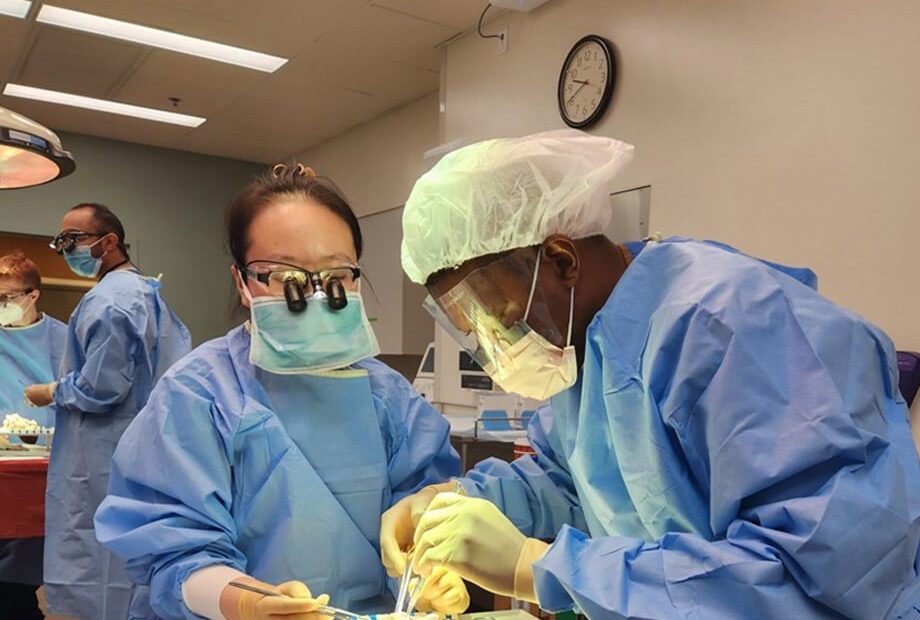Photo courtesy of the author.
“I think this stitch could be placed a little closer to the last one,” a resounding voice said through the screen. In the simulation lab, 10 surgery fellows and residents gathered at 8 a.m., each with their own simulated mitral valve (modified from a pacifier) on the table, trying to perform a mitral valve repair. Assistants hovered around the tables, taking pictures and videos, and uploading them to the screen. More than 3,800 miles away, the professor was seated comfortably in his home office in Belgium, sipping on his afternoon tea while watching the screen and providing immediate feedback.
Our simulation lab on mitral valve repair was held during the height of the COVID-19 pandemic. At the time, cardiac surgery case volumes had dwindled, and the cardiovascular ICU was instead filled with patients with COVID. Across the country, surgical trainees were redeployed to other units to help combat the pandemic. Even when they were operating, the complexity of cases had decreased due to limited resources, and resident autonomy had declined significantly. Surgical education suffered as well. Institutional conferences and didactics were moved to Zoom, and many regional/national conferences were canceled completely.
Under these circumstances, this lab session offered a unique learning opportunity during a time when these opportunities were scarce. The trainees were able to learn and practice their surgical skills while receiving immediate feedback, just as they would in the operating room. Unlike the operating room, however, this training was carried out in a low-stress environment with ample time for correction and fine-tuning of surgical skills. In addition, with the assistance of Zoom, we were able to learn from an expert in the field thousands of miles away. Simulation-based training has been increasingly recognized as a potential solution to the various negative impacts imposed by the pandemic. In fact, during a survey of cardiothoracic surgery trainees [1], more than 80% thought that simulation was an important tool in improving surgical skills and should be used to enhance training and education.
The simulation lab sessions during the pandemic were so well received that simulation, already built into the cardiac surgery fellowship curriculum at Johns Hopkins, was further expanded. And this trend continued even when surgical volumes and complexity returned to pre-pandemic levels. As our experiences grew, the simulation lab also became more creative: Pressurized animal aorta was used for simulation of cannulation, the first step in connecting the patient to the heart-lung machine; pig hearts were used for learning different congenital heart lesions, where the anatomy was altered and lesions added to simulate real pathologies; most recently, we performed a thoracoabdominal aortic repair in a pig, one of the most challenging operations in cardiac surgery, in which the skills of teamwork and crisis management were put to the test.
Three years into the pandemic, we have learned many things about teamwork, innovation and resilience. This applies not only to clinical practice, but also to education, as in the example of using simulation for learning. As we continue to improve surgical education, simulation will continue to play an integral role in training.
References
- Shafi A.M.A, Sheikh A.M, and Awad W.I. Comparison of cardiothoracic surgical training before and during the COVID-19 pandemic in the United Kingdom. J Thorac Cardiovasc Surg Open.2021; 7: 394-410
Related Content
- Fellowship Experience During a Pandemic
- Xenotransplantation: The Present Future
- New Technologies Bring Surgery into the World of Big Data
Want to read more from the Johns Hopkins School of Medicine? Subscribe to the Biomedical Odyssey blog and receive new posts directly in your inbox.
